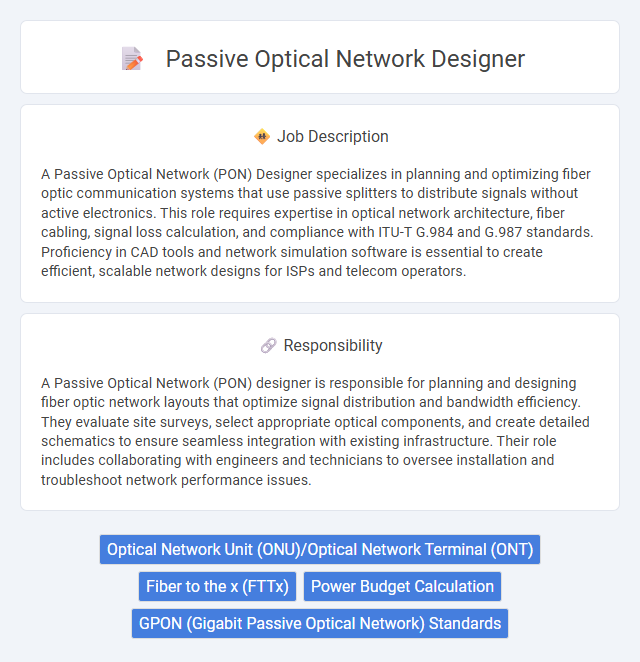
A Passive Optical Network (PON) Designer specializes in planning and optimizing fiber optic communication systems that use passive splitters to distribute signals without active electronics. This role requires expertise in optical network architecture, fiber cabling, signal loss calculation, and compliance with ITU-T G.984 and G.987 standards. Proficiency in CAD tools and network simulation software is essential to create efficient, scalable network designs for ISPs and telecom operators.
Individuals with a strong technical background and an aptitude for meticulous planning and problem-solving are likely to excel as Passive Optical Network (PON) designers. Those who thrive in roles requiring attention to detail and precision in designing optical communication systems may find this job well-suited to their skills and interests. Conversely, candidates who prefer less technical work or struggle with complex network architectures might not find this position compatible with their strengths.
Qualification
A Passive Optical Network (PON) designer requires expertise in fiber optic technologies, network architecture, and telecommunication standards such as ITU-T G.984 and G.987. Proficiency in CAD software and network simulation tools is essential for creating detailed layout designs and ensuring optimal signal distribution. Strong knowledge of bandwidth allocation, optical components, and network security protocols is critical for designing efficient and scalable PON systems.
Responsibility
A Passive Optical Network (PON) designer is responsible for planning and designing fiber optic network layouts that optimize signal distribution and bandwidth efficiency. They evaluate site surveys, select appropriate optical components, and create detailed schematics to ensure seamless integration with existing infrastructure. Their role includes collaborating with engineers and technicians to oversee installation and troubleshoot network performance issues.
Benefit
A Passive Optical Network (PON) designer likely benefits from high demand in telecommunications, which may lead to competitive salaries and job stability. Opportunities for career growth and skill development could be significant due to evolving fiber optic technologies. The role probably offers a chance to work on cutting-edge infrastructure that supports high-speed internet and communication services.
Challenge
Designing a Passive Optical Network (PON) likely involves complex challenges related to optimizing fiber optic signal distribution and ensuring high network reliability. Addressing issues such as minimizing signal loss, managing network scalability, and integrating advanced technologies may frequently test a designer's problem-solving skills. The probability of encountering evolving industry standards and rapid technological shifts suggests continuous adaptation is essential in this role.
Career Advancement
A Passive Optical Network (PON) Designer specializes in creating efficient fiber-optic communication systems, providing a critical foundation for high-speed internet infrastructure. Career advancement in this field often involves progressing to senior network architect roles or project management positions, where strategic planning and system optimization play a key role. Developing expertise in emerging technologies such as 10G PON and integration with 5G networks significantly enhances professional growth opportunities.
Key Terms
Optical Network Unit (ONU)/Optical Network Terminal (ONT)
A Passive Optical Network (PON) designer specializing in Optical Network Unit (ONU) and Optical Network Terminal (ONT) components develops and optimizes fiber optic communication solutions that deliver high-speed broadband connectivity. Expertise in ONU/ONT hardware configuration, signal processing, and interoperability standards such as GPON and XG-PON is essential for designing scalable, efficient fiber-to-the-home (FTTH) networks. This role involves ensuring seamless data transmission, low latency, and robust network performance through precise ONU/ONT placement, software integration, and troubleshooting within passive optical infrastructure.
Fiber to the x (FTTx)
A Passive Optical Network (PON) designer specializing in Fiber to the x (FTTx) develops and optimizes fiber optic infrastructure to deliver high-speed broadband solutions for residential, business, and mobile network applications. Expertise in designing point-to-multipoint fiber access networks involves selecting appropriate optical splitters, determining fiber routing, and ensuring compliance with ITU-T and IEEE standards to maximize signal quality and network scalability. Proficiency in tools like AutoCAD, GIS mapping, and simulation software is essential for creating detailed network layouts and addressing physical and environmental constraints.
Power Budget Calculation
A Passive Optical Network (PON) designer specializes in calculating power budgets to ensure optimal signal strength across fiber optic links. Accurate power budget calculation involves analyzing fiber attenuation, connector losses, splice losses, and splitter insertion loss to maintain signal integrity within specified thresholds. Mastery in this process guarantees reliable network performance and compliance with industry standards such as ITU-T G.984 and IEEE 802.3ah.
GPON (Gigabit Passive Optical Network) Standards
A Passive Optical Network (PON) designer specializing in GPON standards develops high-capacity fiber-optic communication systems that deliver gigabit speeds to end-users using ITU-T G.984 specifications. Expertise in GPON encompasses designing optical line terminals (OLTs), optical network terminals (ONTs), and ensuring compliance with wavelength allocation, downstream/upstream data rates, and network topology requirements. Proficiency in GPON enables the creation of scalable, cost-effective broadband infrastructures supporting triple-play services and future-proofing fiber deployments.
 kuljobs.com
kuljobs.com